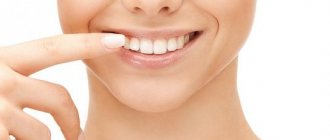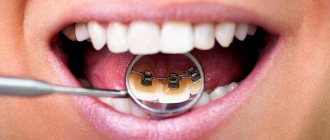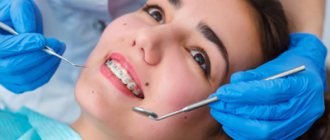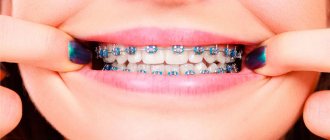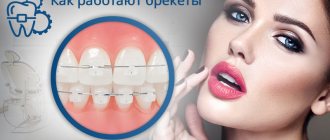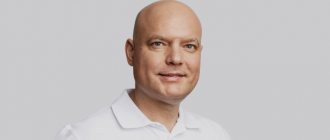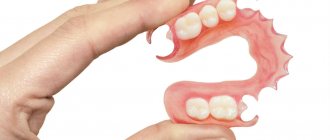Choosing braces for adults is a balance between aesthetics, treatment effectiveness and price. It is difficult for ordinary people to navigate the variety of systems. In addition, orthodontic firms and commercial dentistry are actively pushing “innovative” expensive models. At the same time, it is not a fact that they are the best: there are budget systems that are no less, and sometimes more, effective.
In the article we will consider: existing types of fixed orthodontic structures, what to consider when choosing a system, which braces are best for an adult and which are most effective after 25 years, as well as the best models from well-known dental companies.
What are the indications for installing braces for adults?
The main indication for straightening teeth in adulthood is the same as in childhood – any malocclusion. Occlusion defects are characterized by:
- crowding;
- incorrect position of teeth;
- diastema and trema - gaps between the anterior and lateral units;
- abnormal development of the lower or upper jaw: micrognathia (reduced size), prognathia (increased size);
- violations of the closure of the jaws, their position relative to each other.
There are no age restrictions. But it is better to correct the bite with braces in adults under 30 years of age, when the maxillofacial skeleton is still mobile and the body has many resources for recovery.
There are no age restrictions for installing braces.
Contraindications are:
- multiple fixed dentures and implants;
- pregnancy and breastfeeding;
- diabetes;
- severe bone diseases - rickets, arthritis, arthrosis;
- HIV, AIDS, tuberculosis.
The main reason why adults want to straighten their teeth is appearance flaws. With disocclusion, the smile and facial features deteriorate, and deep wrinkles appear early. Often people with malocclusion are embarrassed to talk, eat in public places, or laugh.
This affects their confidence and, consequently, success in their careers and personal lives.
But it’s worth correcting your bite not only to improve your appearance. Occlusion defects are fraught with more serious consequences due to difficult hygiene, uneven distribution of chewing load and poor primary food processing. Among them:
- frequent diseases of teeth and gums;
- rapid abrasion of individual units;
- dysfunction of the temporomandibular joint (TMJ), arthritis, arthrosis;
- neuralgia;
- pathologies of the gastrointestinal tract;
- diseases of the respiratory system.
The main reason why adults wear braces is appearance flaws, complexes
Therefore, adults often turn to orthodontists for help if they did not receive appropriate treatment in childhood.
What to pay attention to: criteria for choosing braces
When selecting braces, you need to decide on 4 parameters:
- Price. Look for clinics where the price is “turnkey”: for the structure itself, its installation, monthly corrections, removal and fixation of the retainer. But still, be prepared that there will be a lot of additional expenses for the treatment of caries, gingivitis, professional cleanings, the purchase of care products, etc.
- Timing and effectiveness of correction. Thus, classic metal braces with ligatures straighten the bite as quickly as possible. While more aesthetic options delay treatment for 3-12 months.
- Comfortable to wear, quick to adapt and easy to clean. The easier it is to get used to the device and care for it, the easier the treatment will be.
- Aesthetics. For some, the invisibility of therapy is more important than the speed of alignment and the cost of the system. Others do not care about this criterion.
By comparing different brace systems according to these 4 criteria, you can choose the best orthodontic design for yourself.
Look for clinics where the price for treatment with braces is “turnkey”
Reviews
We ask everyone who has corrected bite defects with the described devices to share the results of treatment in the comments to the article.
If you find an error, please select a piece of text and press Ctrl+Enter.
Tags braces
Did you like the article? stay tuned
Previous article
Green implants – a German product for solving any problem
Next article
What is brace activation and how often is it done?
Vestibular or lingual braces – which is better?
Vestibular
Vestibular braces are attached to the outside of the teeth. This type is considered classic, it is the most common and cheapest. And models of external systems are produced by almost all manufacturers of orthodontic equipment.
External structures are made from any materials - metal alloys, plastic, transparent and opaque ceramics. They are the most reliable, easy to maintain and easy to install. In addition, they can correct any occlusion pathologies.
The only disadvantage of vestibular systems is visibility. They are visible on the teeth, and patients often have complexes because of this. But this point can be circumvented by using brackets made of aesthetic materials: plastic and ceramics. In this way, it will not be possible to completely hide the device, but it will no longer be noticeable.
The best vestibular models are:
- “SmartClip” from 3M Unitek, America;
- “Master” from American Orthodontics, USA;
- “Orthos” from Ormco, USA.
Vestibular braces are attached to the outside of the teeth
Lingual
Lingual braces are placed on the lingual side of the teeth. Initially, these systems were developed to treat specific malocclusions: posteriorly displaced jaws, deep bites, and in patients with clinically low crown heights. Today, internal models are better than vestibular models at these tasks. But they began to be used en masse mainly because of their ideal aesthetics - the structures are absolutely invisible, for which they received the name “invisible”.
Since the internal braces are not visible, the brackets are always made of metal alloys: gold, titanium, cobalt or nickel-chrome.
Invisibility is the main advantage of lingual devices. Because of this, they are chosen by public people: media figures, businessmen, artists, speakers. In addition, women prefer it more often than men. But this advantage comes at a price.
So, internal systems:
- they rub the tongue very hard - until there are cuts, cracks and blood;
- they seriously impair diction - you have to learn to speak in a new way, but you won’t be able to achieve perfect speech;
- require adherence to a strict diet;
- greatly complicate the doctor’s work;
- make hygiene difficult;
- often break down;
- very expensive - their prices are at least 3 times higher than vestibular models.
Lingual systems are also the best choice for athletes and wind instrument players. Invisible models break less when hit and do not cling to the embouchure of a saxophone, trumpet, etc.
This is what lingual braces look like on teeth.
Therefore, lingual products are not widely used. Most of them are manufactured abroad. In addition, the majority of systems are made using individual impressions. So the treatment is drawn out: it takes time to send the diagnostic model to a foreign laboratory, make a design based on it and send it to the customer clinic. And if at least one part breaks, you have to repeat the process.
There are few invisible models. The main ones:
- “Incognito” from TOP-Service für Lingualtechnik GmbH, Germany;
- “STb” from ORMCO”, USA;
- “WIN”, from DW Lingual Systems GmbH, Germany;
- “2D” from Forestadent, USA;
- “In-Ovation L” from Dentsply GAC, America.
| Parameter | Vestibular | Lingual |
| Strength | High. | Low. |
| Timing for teeth straightening | 1.5-2 years. | 2-3 years. |
| Prevalence | High. | Weak. |
| Aesthetics | Medium or low. | High. |
| Difficulty of installation | Low. | High. |
| Hygiene | Moderately complex. | Extremely difficult. |
| Adaptation speed | Fast, 1-2 weeks. | Long-term, from 3 weeks to a couple of months. Sometimes the patient never manages to get used to it completely. |
| Treatment effectiveness | High. | Good, but in some clinical cases they work worse, in others they work better than classical systems. |
| Comfortable to wear | Good. | Low. |
| Painfulness of therapy | Average. | High. |
Which braces to choose – ligature or non-ligature?
Ligature
In ligature braces, the power arc is attached to the brackets using special elastic fasteners - ligatures. They are made of rubber or wire.
Treatment with braces can be adjusted at any stage
Ligatures allow you to control the strength and type of fastening of the arch - to do this, you just need to tighten or loosen the rubber bands. Thus, with the active fixation method, the power wire is in close contact with the braces: this method is better suited at the final stages of treatment. And with passive, the arc slides freely in the grooves and exerts slight but uniform loads, which are ideal at the beginning of alignment.
The ability to control the tension force and freely change the method of fixing the power arch provides ideal biomechanical loads on the teeth. Treatment can be adjusted at any stage, quickly adapt to force majeure and eliminate them.
In addition, additional elements can be freely installed on ligature structures: elastics, traction, orthodontic mini-implants, etc. They will be needed when correcting complex malocclusion pathologies. Thus, classical systems are the ideal choice for severe anomalies.
But there are also disadvantages to this approach:
- ligatures must be tied manually, which makes the doctor’s work difficult;
- elastic bands have to be changed or tightened every 3-4 weeks;
- fastenings complicate hygiene.
True, against the backdrop of full control of therapy, these shortcomings are insignificant. And experienced orthodontists who are not interested in selling innovative systems will prefer to work with ligature models.
The best models of ligature braces:
- “Victory” from 3M Unitek, America;
- “Orthos” and “Mini Diamond” from Ormco, USA;
- “Master” from American Orthodontics, USA.
Ligature-free models simplify the work of the doctor and the life of the patient
Unligated
Unlike ligature braces, in self-ligating braces the fastening is carried out not with rubber bands, but with a special mechanism. Each bracket is equipped with a special clip lock. After positioning the staples and installing the archwire, the doctor only needs to snap them into place.
On the one hand, ligature-free models simplify the doctor’s work and the patient’s life. They are easy to install, they look more beautiful, and they are easy to care for, since there are no additional elements into which food would get stuck. And there is no longer any need to re-tie the ligatures every month.
But, on the other hand, self-ligating models have a drawback that eliminates all the advantages: the impossibility of changing the type of arch fixation. You have to use only the one that was originally included in the system: passive or active.
Due to the fact that the method of attachment cannot be changed, treatment is carried out with irrational biomechanical loads. This slows down therapy and sometimes worsens the final result. In addition, you have to dodge: use more power arcs and change them often.
But this doesn’t always help. Therefore, some self-ligating dental braces for adults are equipped with special hooks or wings. With their help, you can switch to the desired type of fixation. True, having already secured the power arc to the ligature and, in fact, turning the non-ligature system into a ligature one.
The remaining advantages that manufacturers attribute to self-ligating brace systems are not confirmed in practice. Among them: less pain in teeth straightening, faster treatment, less pressure on the crowns, etc.
Some self-ligating braces are equipped with special hooks.
Most often, the following non-ligating braces are installed:
- “Clarity SL” from 3M Unitek, America;
- “In-Ovation” from Dentsply GAC, USA;
- “Damon” from Ormco, America.
| Parameter | Ligature | Self-ligating |
| Strength | Average. | High. |
| Timing for teeth straightening | 1.5-2 years. | 1.5-2 years. |
| Prevalence | High. | High. |
| Aesthetics | Medium or low. | Above average or high. |
| Difficulty of installation | High. | Low. |
| Hygiene | Difficult. | Lightweight. |
| Adaptation speed | Average duration, 1.5-3 weeks. | Fast, 1-1.5 weeks. |
| Treatment effectiveness | High. | Below the average. |
| Comfortable to wear | Satisfactory. | Good. |
| Painfulness of therapy | Average. | Average. |
Brushing teeth with non-ligature braces
Despite the fact that self-ligating braces do not contain unnecessary parts that contribute to the accumulation of plaque, they must be cleaned no less thoroughly. For good hygiene, special orthodontic brushes are used - with a recess for braces and mono-beam, orthodontic brushes, superfloss with a hard tip (for convenient use with braces) and an irrigator. To prevent dental health with braces, professional oral hygiene is necessary at least once every six months.
The result of bite correction using Damon non-ligature braces for 1.5 years
What are the best braces based on materials used?
Several materials are used to make braces:
- various metal alloys;
- opaque polycrystalline aluminum oxide ceramics;
- transparent ceramics made of monocrystalline aluminum oxide (so-called artificial sapphires).
There are also plastic braces, but they are rarely used in adults. Such structures are fragile, quickly deformed and stained. But the main thing is that they exert little pressure on the teeth, so they are not able to effectively displace crowns after 25 years. Although sometimes plastic systems are installed for weak bite defects.
However, only the brackets are made from different materials. The remaining parts in any model are made of metal (archwires, orthodontic rings) or rubber and wire (ligatures, rods).
Metal braces are the most commonly used models.
Metal bracket system – reliability, quality, affordable price
Metal braces are classic systems. They are used most often. Almost every manufacturer has such models.
Metal systems compare favorably with others:
- high strength;
- low price;
- the ability to eliminate serious pathologies of occlusion that other systems cannot cope with;
- the ability to secure auxiliary orthodontic devices: rods, face bows, springs, mini-implants without the risk of breakage and peeling off.
Another important factor is the speed of teeth straightening. For iron braces it is the highest: because... the arc and the grooves that hold it are made of the same materials. The combination of “metal” + “metal” ensures the best sliding of the power wire: as a result, it puts more pressure on the teeth and moves them faster.
There are 3 main disadvantages of metal braces:
- Low aesthetics. The structures are very noticeable on the teeth.
- Highly traumatic. Although modern metal models have the smallest brackets of all types of braces, have smoothed corners and a low profile, they cannot be polished perfectly. Therefore, they strongly rub the mucous membrane: the parts that cut the lips and cheeks are covered with orthodontic wax.
- Possibility of allergies. Occurs on devices made of nickel- or cobalt-chromium alloys.
Review of specific types of metal braces
The following 6 are considered the best metal models:
- “Alexander” (Ormco, USA). Classical ligature systems. The brackets in them are single (with the exception of plates on the upper front teeth), which made it possible to reduce the size of the braces, make them as flat and narrow as possible, and increase the distance between them. This ensures the most effective and physiological effect of the power arc on the crowns.
- “Damon Q” (Ormco, USA). "Damon" is the most popular metal system of the self-ligating type. The brackets in them are smaller, equipped with modernized latches and double grooves. This design allows the braces to securely hold the arch and also exert precise pressure on the teeth without strong pressure and damage to adjacent tissues and ligaments.
- “Insignia SL” (Ormco, USA). One of the few individualized external braces: systems are developed using 3D models for each patient. This allows you to predict treatment, avoid mistakes when aligning teeth and find out the result of therapy in advance. True, because of this same approach, the duration of the course increases, as does the cost of the structure.
- “Pilot” (Russia). Classic vestibular ligature models, the cheapest among metal systems. There is nothing innovative about braces, and the designs themselves have not been modernized for several years. But they do the main task well.
- “Sprint” (Forestadent, Germany). They are produced in 4 variations: classic, with reduced and miniature bracket sizes (Mini and Micro), as well as with hooks in the body of the braces - Mini Mono. The Sprint features comfortable polished plates with smooth corners and patented 3D bases that hold the structure securely. In addition, all varieties, with the exception of Mini Mono, are made without nickel, which eliminates allergies.
- “Master” (American Orthodontics). They are produced in 3 variations: classic, with the size of brackets reduced by 17% (Mini Master) and by 25% (Mini Master LP). Thanks to the tiny brackets, they are suitable for severe crowding and low crown heights. In addition, they are comfortable, slightly rub the mucous membrane, easy to care for and hardly noticeable on the teeth.
Damon Q - popular self-ligating metal systems
A specific model is selected together with the orthodontist. He will determine which system is best suited to solve the problems of a particular patient.
Ceramic braces and their advantages and disadvantages
Ceramic braces were invented as an aesthetic alternative to noticeable, gray metal models. They are mostly put on by adults, because... For them, appearance is more important than for children and adolescents.
In such models, the brackets are made of opaque ceramics (medical porcelain) - polycrystalline aluminum oxide. Its color is matched to the patient’s teeth, so the plates merge with the enamel and are almost invisible when talking, smiling and in photographs.
The dark metal arc remains visible. It is camouflaged by painting it white. But, because the power wire constantly moves in the grooves and rubs against them; in some areas the pollination peels off over time.
Ceramic bracket structures are hypoallergenic, quite durable, resistant to deformation and staining. However, with heavy consumption of food and drinks with pigments, as well as smoking, the color of the brackets will change.
Ceramic braces on teeth on one side are more comfortable than metal ones, because... as smooth and polished as possible. On the other hand, porcelain brackets are very large: due to the higher fragility of the material, they cannot be made as small as iron ones. So get ready for:
- adaptation will be long;
- diction will change in the first weeks;
- the inside of the lips and cheeks will be very chafed;
- When removed, the brackets may crumble.
In ceramic models, the brackets are made of opaque ceramics.
3 types of ceramic models are produced:
- All-ceramic. In them, the body of the braces, the groove and the lock (in self-ligating devices) are made of medical porcelain. Such systems are the most aesthetic. However, due to the reduced friction between the metal archwire and the ceramic anchor, the power wire glides freely: this reduces the pressure on the teeth and lasts longer for alignment. In addition, the risk of breakage is high.
- With metal lock. These are ceramic self-ligating systems in which the bracket and groove are made of ceramic, and the latch-clip is made of metal.
- With metal groove. Such models lose in aesthetics. But the combination of a metal arch with a metal groove provides an ideal effect on the units and speeds up the alignment of the bite.
The best models of ceramic braces:
- “Damon Clear” from Ormco, USA;
- “In-Ovation-C” from Dentsply GAC, America;
- “Clarity” (ligature) and “Clarity SL” (self-ligating) from the American company 3M Unitek;
- “Empower Clear” and “Virage” from American Orthodontics, USA;
- “Aspire” from Forestadent, Germany;
- “Reflections” from Ortho Technology, America;
- “Crystal” from SIA Orthodontic, Italy;
- “Diamante” from Orthodontic design & production”, USA.
There are 3 types of ceramic braces
For those who care about aesthetics – invisible braces
The most aesthetically pleasing exterior models are sapphire. They, like lingual braces, were called invisible braces. They are transparent and able to blend with tooth enamel. True, invisibility disappears in bright light: but in the glare of sunlight or neon rays, the brackets sparkle like precious stones and look like decoration.
Sapphire systems are similar to ceramic ones: they are also made from aluminum oxide, only monocrystalline. That's why they are transparent.
Otherwise, the systems are the same: they have the same varieties, pros and cons. The only thing is that sapphire ones look more beautiful, but at the same time, they are more susceptible to staining and breakage.
When choosing between aesthetic models, focus on the color of your teeth. So, if you have grayish or yellowish enamel, install ceramic systems, and if it is light and slightly transparent, use sapphire systems.
The most popular models of sapphire braces:
- “Aesthetic” from Forestadent, Germany;
- “Inspire ICE” from Ormco, USA;
- “MISO” from HT Corporation, South Korea;
- “Pure” from Ortho Technology, America.
In order to simultaneously achieve high aesthetics and reduce the cost of treatment, we developed a cheap analogue of porcelain braces - combined. They combine metal and ceramic or sapphire parts. For example, aluminum oxide brackets are placed in the smile area, and iron brackets are placed on the lateral teeth. Or a transparent model is attached to the upper jaw, and a titanium model to the lower jaw, which is not noticeable when talking and laughing.
| Parameter | Metal | Ceramic | Sapphire |
| Strength | High. | Average. | Average. |
| Timing for teeth straightening | 1-1.5 years. | 1.5-2.5 years. | 1.5-2.5 years. |
| Prevalence | High. | Average. | Average. |
| Aesthetics | Low. | Average. | High. |
| Difficulty of installation | Normal. | Normal. | Normal. |
| Hygiene | Regular. | Medium difficulty. | Medium difficulty. |
| Adaptation speed | 1-1.5 weeks. | 1.5-2 weeks. | 1.5-2 weeks. |
| Treatment effectiveness | High. | Average. | Average. |
| Comfortable to wear | Average. | Average. | Average. |
| Painfulness of therapy | Moderate. | Average. | Average. |
Advice from orthodontists
Children
Children can only have braces after 12 years of age. The minimum threshold for installing braces on the entire dentition is 10 - 12 years. At this age, vestibular metal braces are usually used.
After the formation of the bones of the facial skeleton and the root system of the teeth is completed, that is, after 14 years, you can use any design of braces according to indications.
Adults
If the patient does not suffer from severe chronic diseases, orthodontic treatment is possible at any age.
But you need to be prepared for the following:
- treatment will last longer than in young people;
- some teeth will be asked to be removed;
- more pressure will be exerted on the teeth, so metal structures are more often recommended for adults;
- treatment will ultimately cost more than under the same clinical conditions, but at a younger age.
The choice of system depends on specific individual characteristics, the degree of deformation of the dentition and patient preferences.
Comparison of bracket systems by cost
Orthodontic treatment is always expensive. Constructions, their installation, activation, correction, retention period and treatment of inevitably creeping diseases of teeth and gums are expensive. The total amount of treatment depends on many factors, but the key one is the type of braces.
So, the cheapest ones are external ligatures made of metal. More aesthetic options - ceramic and combined - will cost more. The prices for sapphire and self-ligating systems are even higher.
Moreover, the cost doubles when combining two innovative developments in one design. For example, ceramic ligatures are 2 times cheaper than self-ligating ceramic ones.
The most expensive types of braces are lingual. The cost of treating one jaw can reach half a million rubles. Only wealthy people can afford them.
Below is a breakdown of prices for treatment with braces in dental clinics in Moscow. The price is for the structure itself and its fixation on one jaw without monthly maintenance and retention period. Prices are valid for 2022.
Result after treatment with braces
| Type of braces | Cost in rubles |
| Vestibular | From 25 to 130 thousand, depending on the type of fixation and bracket materials. |
| Lingual | 200-300 thousand. |
| Ligature | From 20 to 100 thousand depending on the type of records. |
| Self-ligating | 90-95 thousand. |
| Metal | 20-30 thousand. |
| Ceramic | 55-60 thousand. |
| Sapphire | 120-130 thousand. |
When choosing braces, follow the following rules. If the budget is limited, the opinions of others are indifferent, or there are severe malocclusions, use metal ligature systems. If finances allow and you want to make the braces on your teeth a little more aesthetically pleasing, order ceramic or combined models. And if appearance is extremely important, and you are not limited by money, undergo treatment with lingual structures.
Leading manufacturers
Braces were first developed in the United States back in 1886. Over the years, the designs have been improved, shortcomings have been corrected, and now they have become convenient devices for correcting bites.
There are many companies producing orthodontic systems, but the most famous, producing products of the highest quality, are the American Ormco, GAC, 3M Unitek.
Ormco
The company began producing dental devices in the last century; their products receive only high marks from dentists and their patients.
A significant advantage of the company is the well-established work of the dealer network , which promptly ensures delivery of products even to distant regions of our country.
The prices of Ormco products are quite high, but the quality of the systems, according to specialists and patients, justifies the costs.
GAC
Dentsplay is the oldest company, producing dental products for more than a century. Dentsplay GAC is its subsidiary, which specializes in the development and production of orthodontic systems.
In the GAC division catalog you can find various modifications of structures made of metal, plastic and ceramics.
3MUnitek
The company has been supplying the market with orthodontic products since 1948. Among her developments is the use of durable stainless steel for the production of braces.
The company also produces self-ligating systems and staples, with a pre-applied adhesive composition on the surface, for quick and easy fastening.
Today, the company's catalog consists of several thousand items of products made using the latest technologies and methods.
Universal devices made of metal and ceramics are in great demand.

